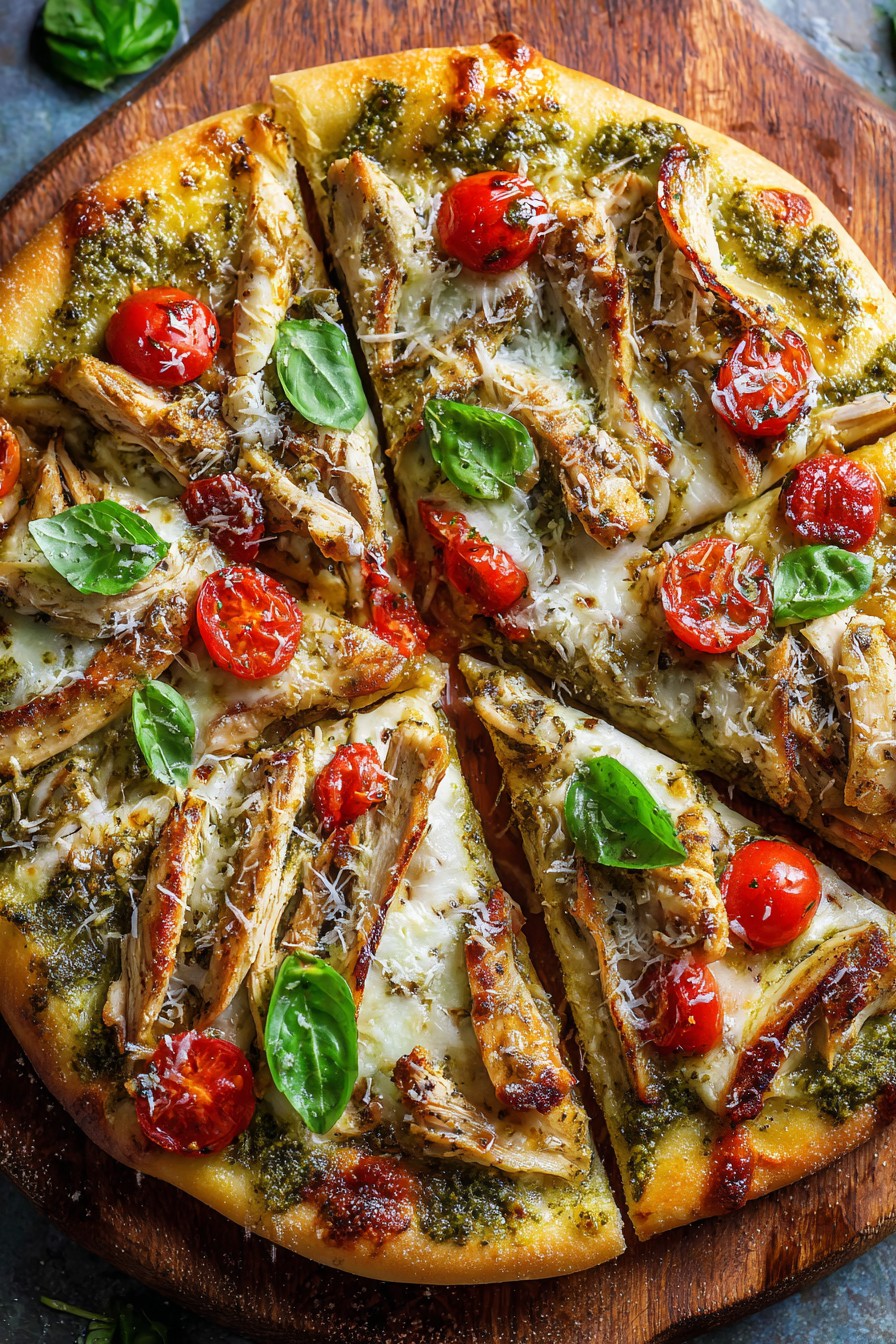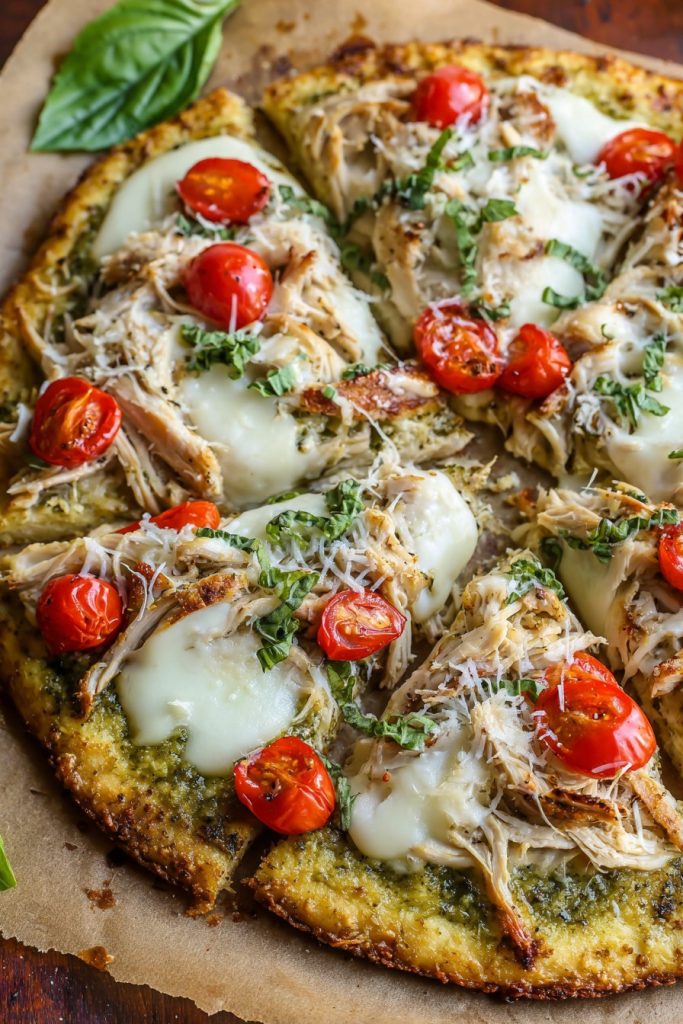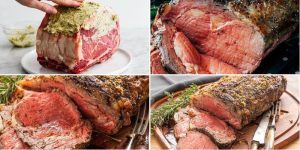Zesty flavors and crispy crusts unite in this chicken pesto pizza that will transform your pizza night forever. Zero excuses needed to indulge in this gourmet-style creation that comes together with minimal effort but delivers maximum deliciousness.
Why This Recipe Works
- The combination of homemade pesto and perfectly seasoned chicken creates layers of flavor that store-bought versions can’t match
- Using pre-cooked chicken saves time while still delivering juicy, tender protein in every bite
- The high-temperature baking method ensures a crispy, golden crust that supports the generous toppings without getting soggy
- Balancing the rich pesto with fresh mozzarella and Parmesan creates a perfect harmony of creamy and sharp cheese flavors
- The addition of cherry tomatoes provides bursts of freshness that cut through the richness of the other ingredients
Ingredients
- 1 pound pizza dough (store-bought or homemade), room temperature
- 1/2 cup basil pesto (homemade or quality store-bought)
- 2 cups cooked chicken breast, shredded or diced
- 8 ounces fresh mozzarella cheese, thinly sliced
- 1/4 cup grated Parmesan cheese
- 1 cup cherry tomatoes, halved
- 2 tablespoons olive oil
- 1 teaspoon garlic powder
- 1/2 teaspoon dried oregano
- 1/4 teaspoon red pepper flakes (optional)
- Fresh basil leaves for garnish
- Cornmeal or flour for dusting
Equipment Needed
- Pizza stone or baking sheet
- Rolling pin
- Pizza cutter
- Mixing bowls
- Measuring cups and spoons
- Oven
Instructions

Prepare Your Pizza Dough and Preheat
Place your pizza stone or baking sheet in the oven and preheat to 475°F for at least 30 minutes to ensure proper heat distribution. While the oven heats, lightly dust your work surface with flour or cornmeal to prevent sticking. Gently stretch your room-temperature dough into a 12-inch circle using your hands or a rolling pin, working from the center outward. Avoid overworking the dough to maintain air pockets that create that perfect chewy texture. The dough should be about 1/4-inch thick with slightly thicker edges for that classic pizza crust rim. Let the shaped dough rest for 10 minutes while you prepare toppings—this relaxes the gluten for easier handling.
Season and Prepare Chicken Topping
In a medium bowl, combine your pre-cooked chicken with olive oil, garlic powder, dried oregano, and red pepper flakes if using. Toss thoroughly until every piece is evenly coated with the seasoning mixture. The oil helps the spices adhere to the chicken and prevents drying during baking. If your chicken seems dry, add another tablespoon of olive oil—moist chicken ensures juicy bites in the final pizza. Let the seasoned chicken sit for at least 5 minutes to allow the flavors to meld. This step transforms simple pre-cooked chicken into a flavor-packed pizza topping that stands up to the bold pesto base.
Assemble the Pizza with Precision
Carefully remove the hot pizza stone from the oven using oven mitts and place your shaped dough on it. Spread the pesto evenly over the dough, leaving about a 1-inch border around the edges for the crust. Layer the fresh mozzarella slices over the pesto, ensuring even coverage but leaving some gaps for the other toppings. Scatter the seasoned chicken pieces evenly across the cheese, followed by the halved cherry tomatoes cut-side up to prevent excess moisture release. Finally, sprinkle the grated Parmesan cheese over everything—this adds a salty, nutty flavor and helps create a beautiful golden-brown finish during baking.
Bake to Perfection
Place the assembled pizza in the preheated 475°F oven and bake for 12-15 minutes. Watch for the crust to turn golden brown and the cheese to become bubbly and slightly spotted with brown areas. The edges should puff up and develop a crisp exterior while remaining soft inside. Rotate the pizza halfway through baking if your oven has hot spots to ensure even cooking. The pizza is done when the bottom crust sounds hollow when tapped and the cheese is fully melted with lightly browned spots. For extra crispness, you can broil for the final 1-2 minutes but watch carefully to prevent burning.
Rest, Garnish and Serve
Remove the pizza from the oven and let it rest on a cutting board for 3-5 minutes before slicing—this allows the cheese to set slightly and makes cleaner cuts. While resting, the crust will continue to crisp up as steam escapes. Sprinkle fresh basil leaves over the hot pizza just before serving to preserve their bright color and fresh flavor. Use a pizza cutter or sharp knife to slice into 8 equal pieces, wiping the blade between cuts for clean edges. Serve immediately while the crust is still crisp and the cheese is wonderfully stretchy—this pizza is best enjoyed fresh from the oven.
Tips and Tricks
For the ultimate crispy crust, consider par-baking your dough before adding toppings. Preheat your pizza stone at 475°F for 30 minutes, then bake the naked dough for 3-4 minutes until it just starts to puff but hasn’t colored yet. Remove, add toppings quickly, and return to oven—this technique prevents soggy bottoms, especially with moist ingredients like pesto and tomatoes. If you’re using homemade pesto, toast your pine nuts lightly in a dry skillet before blending—this deepens their flavor dramatically. For chicken, poach breasts in seasoned water rather than baking or grilling—this keeps them incredibly moist and perfect for shredding. Use a thermometer to ensure chicken reaches 165°F internally during initial cooking.
Cheese selection matters tremendously—fresh mozzarella has higher moisture content than low-moisture varieties, so pat it dry with paper towels before slicing to prevent excess water on your pizza. For extra flavor, mix some provolone or fontina with your mozzarella. When stretching dough, never use a rolling pin for the entire process—start with rolling, then finish by hand-stretching to preserve those beautiful air bubbles. If your dough keeps shrinking back, let it rest covered for 10 minutes—the gluten needs time to relax. For perfect browning, brush the crust edges with olive oil or garlic butter before baking—this creates that gorgeous golden color and adds flavor.
Oven temperature is critical—if your oven doesn’t reach 475°F reliably, consider using a pizza steel instead of a stone, as it conducts heat more efficiently. Place your oven rack in the lowest position for the crispiest bottom crust. If making multiple pizzas, keep prepared dough balls covered with a damp cloth to prevent drying. For extra flavor, infuse your olive oil with garlic and herbs before brushing on the crust. Leftover pizza reheats best in a skillet over medium heat with a lid—this re-crisps the bottom while melting the cheese again. Avoid microwaving, which makes the crust rubbery.
Recipe Variations
- Mediterranean Twist: Replace chicken with grilled artichoke hearts, kalamata olives, and crumbled feta cheese. Add roasted red peppers and a drizzle of balsamic glaze after baking for a Greek-inspired version that’s perfect for vegetarians but still packed with protein and flavor.
- BBQ Chicken Pesto Pizza: Use barbecue sauce instead of pesto as the base, mix shredded chicken with extra BBQ sauce, and add red onion slices and cilantro. The combination of smoky BBQ with fresh pesto-marinated chicken creates an unexpected flavor explosion that will become a new family favorite.
- White Pizza Version: Skip the tomatoes and use a garlic cream sauce base instead of pesto, then top with chicken, ricotta dollops, and spinach. Finish with lemon zest and extra Parmesan for a richer, creamier pizza that still features chicken as the star protein.
- Break-for-fast Pizza: Top with scrambled eggs, bacon crumbles, and extra cheese before baking, then finish with fresh chives. Serve for brunch with a side salad—the pesto adds an herbal note that complements breakfast flavors surprisingly well.
- Spicy Buffalo Style: Toss chicken in buffalo sauce instead of seasoning, use blue cheese crumbles instead of mozzarella, and add celery slices after baking. The pesto base provides an herbal counterpoint to the spicy buffalo flavor that creates a balanced, exciting pizza experience.
Frequently Asked Questions
Can I use store-bought rotisserie chicken for this recipe?
Absolutely! Store-bought rotisserie chicken works wonderfully and saves considerable time. Look for plain or lightly seasoned varieties rather than heavily smoked or BBQ-flavored chickens, as those might clash with the pesto. Remove the skin and shred the meat using two forks, discarding any bones or cartilage. Rotisserie chicken typically yields about 3 cups of meat, so you’ll have extra for salads or sandwiches. The natural juiciness of rotisserie chicken prevents dryness in the baked pizza. If using pre-cooked chicken, reduce the baking time by 1-2 minutes since the chicken only needs warming through rather than cooking.
How do I prevent my pizza crust from getting soggy?
Soggy crust is often caused by excess moisture from toppings or insufficient oven heat. Always preheat your pizza stone or baking sheet for at least 30 minutes—this creates instant heat transfer that crisps the bottom quickly. Pat fresh mozzarella dry with paper towels and place tomatoes cut-side up to minimize liquid release. Don’t overload with pesto—1/2 cup is sufficient for a 12-inch pizza. If using homemade dough, ensure it’s not too thick in the center where moisture accumulates. Baking at the bottom rack position helps crisp the base. Let the baked pizza rest on a wire rack rather than a plate to allow steam to escape from the bottom.
Can I make this pizza gluten-free or low-carb?
Yes! For gluten-free version, use your favorite gluten-free pizza dough mix or pre-made crust—many brands now work well. Look for ones with xanthan gum for better elasticity. For low-carb, use a cauliflower crust (store-bought or homemade) or a fathead dough made with almond flour and cheese. Since these alternative crusts bake differently, follow package instructions for pre-baking if required. Reduce baking temperature to 425°F for cauliflower crusts to prevent burning. The toppings work perfectly with any base, so feel free to experiment. For keto version, ensure your pesto doesn’t contain added sugar and watch cheese quantities to meet macros.
How long does leftover pizza keep, and what’s the best way to reheat it?
Leftover pizza keeps well refrigerated for 3-4 days in an airtight container. For freezing, wrap slices individually in plastic wrap then foil, and freeze for up to 3 months. The best reheating method is in a skillet: place cold pizza in a dry non-stick skillet over medium heat, cover with a lid, and heat for 3-5 minutes until the bottom is crisp and cheese is melted. For oven reheating, place on a baking sheet at 375°F for 8-10 minutes. Avoid microwaving alone—if you must, place a cup of water in the microwave to prevent rubberiness and use a paper towel underneath to absorb moisture.
Can I prepare any components ahead of time?
Definitely! The seasoned chicken can be prepared up to 3 days ahead and stored refrigerated. Pesto can be made 2-3 days in advance—press plastic wrap directly onto the surface to prevent browning. Pizza dough can be refrigerated for up to 5 days or frozen for 3 months. Assemble the pizza just before baking for best results—if assembled too early, the dough can get soggy. For parties, have all components pre-measured and organized for quick assembly. If you must assemble ahead, refrigerate for no more than 1 hour before baking, and add tomatoes just before going in the oven to maintain their freshness.
Summary
This chicken pesto pizza combines crispy crust, flavorful pesto, juicy chicken, and melted cheeses for a restaurant-quality meal at home. Perfect for weeknights or entertaining, with endless variations to keep it exciting.
Chicken Pesto Pizza
6
servings20
minutes15
minutesIngredients
Instructions
- 1 Preheat oven with pizza stone to 475°F for 30 minutes
- 2 Season chicken with olive oil, garlic powder, oregano, and pepper flakes
- 3 Stretch dough to 12-inch circle on dusted surface
- 4 Spread pesto, add cheeses, chicken, and tomatoes
- 5 Bake 12-15 minutes until golden and bubbly
- 6 Rest 5 minutes, garnish with basil, slice and serve



